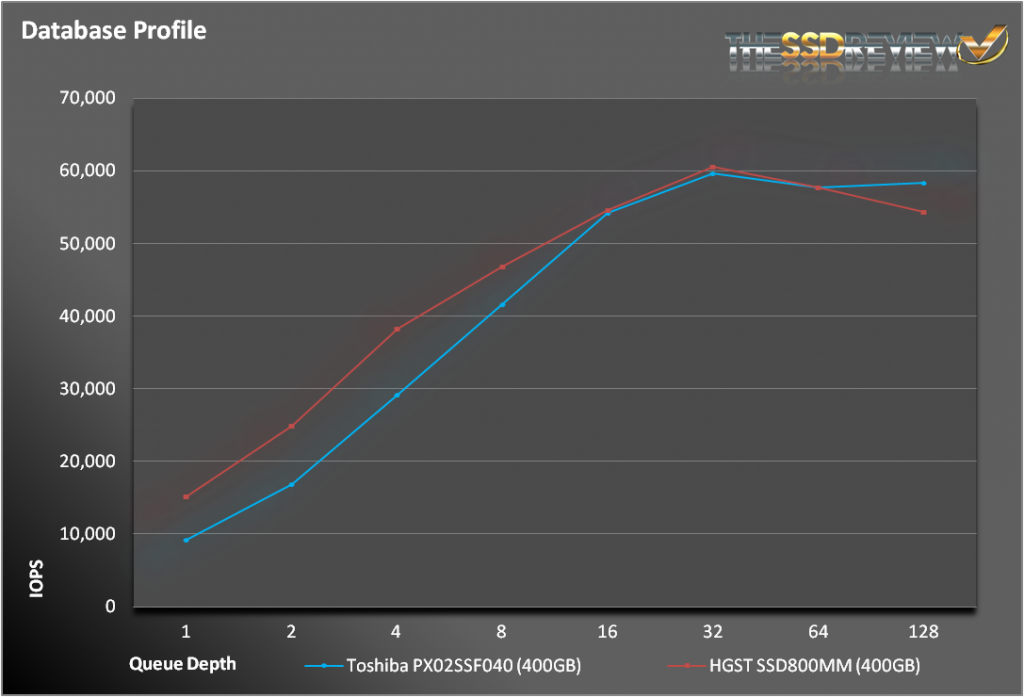SERVER PROFILES
While synthetic workloads do a great job of testing the underlying technology and reporting easy to understand results, they aren’t always indicative of how the drive will be used by the end user. Workloads that simulate enterprise environments try to bridge that gap without being overly complex.
The database profile is 8K transfers, and 67% percent of operations are reads.
For our database profile, the SSD800MM was the clear winner at lower queue depths. Increasing the queue depths gave the edge to the PX02SS, but only slightly.
The fileserver profile is based on an 80% read/20% write mix. Its made up of blocksizes from 512 to 64K, each making up a different percentage of the access pattern.
The pattern is: 512 bytes=10%, 1k=5%,2k=5%, 4k=60%, 8k=2%, 16k=4%, 32k=4%, 64k=10%.
Based on the results of the SNIA tests, this workload was tailored made for the Toshiba PX02SS. The perfect read/write mix with just the right transfer sizes. To say the Toshiba won is an understatement. The PX02SS held a nearly 50% advantage at half the queue depths.
The webserver profile is similar to the fileserver profile, but has some additional 128K and 512K accesses thrown in for good measure. Additionally, the profile is 100% read.
The PX02SS had more trouble with the fileserver profile. While both drives stayed even at lower queue depths, the HGST pulled away at higher queue depths. Even though the fileserver and webserver profiles are similar, the lack of writes allow the superior read performance of the SSD800MM to take over.
Overall, the Toshiba performed really well in tests where there was a healthy mix of reads and writes with larger transfer sizes. Considering the lead the HGST has at the corners, it was surprising that the Toshiba has such a good showing with mixed workloads.
FINAL THOUGHTS
For enterprise SSD storage, 2013 will be looked back at as the year of 12Gbps SAS. No company has been more committed to that than Toshiba. From the high performance PX02SM, to the read-intensive PX03SN and the high endurance PX02SS, Toshiba is the only company with a complete 12Gbps product line. We love to see options for the consumers, especially with cutting edge technology. Toshiba has developed a very competent 12Gbps controller and they are leveraging it heavily. That is great for them and great for the industry.
On the performance side, the PX02SS held its own against the HGST SSD800MM, especially with read operations. In two of our three server profile tests, the PX02SS was close, but not quite fast enough to win. The fileserver profile, on the other hand, was a clear victory. While the PX02SS could not match the 150K read IOPS of the SSD800MM, it put up a very respectable 135K. For write performance, the PX02SS was no match for the HGST drive. The SSD800MM consistently beat the PX02SS whenever write operations started to outpace reads. It was disappointing that write performance wasn’t higher, considering many enterprise SATA drives can easily pass 410MB/s for sequential writes.
If money was no object, we would pick the HGST SSD800MM every day of the week. The raw performance is just unparalleled in the 2.5″ SATA/SAS market. But, we live in a world where enterprise drive costs are a very real concern, especially when costs are this high. Because of that, HGST has left the door cracked open. While HGST does not provide pricing information on their enterprise drives, Toshiba was more than willing to share list prices. If Toshiba is able to undercut HGST by even 10%, the PX02SS will become a much more compelling product. But, if pricing is on par with the HGST, the choice is pretty clear.
 The SSD Review The Worlds Dedicated SSD Education and Review Resource |
The SSD Review The Worlds Dedicated SSD Education and Review Resource | 


156% op!?!? Man…I’d have been impressed with just 50…lol Glad to see Tosh keeping their game up re: the high end…hope that bleeds over into the consumer market eventually.
Check out your OP calculations!!
1024 GiB of NAND physically installed.
400 GB of user space -> 372.53 GiB
OP = 1 – (372.53 / 1024) = 0.6362
—> 63.62% of the available NAND space is used as OP
It is a 400GB SSD. There is 1024GB (16×64) of memory. Let’s stay away from mixing GiB abd GB and leave it as a very simple calculation which has been accepted by the industry for some time now. Thanks ahead!
This is like saying that [imperial] miles are [nautical] miles, even though in different contexts they mean different things. Whenever the chance of mixing them up arises, you have to clarify what you’re talking about, otherwise you only create confusion and room for error when calculations are involved, like in this case.
We appreciate your comments and believe they display the clarification well. Tx!
Responding just to your point of OP always being calculated on the total amount of NAND, that is not true, it is the amount provisioned over the usable space. So it is (1024-400)/400=1.56 or (1024/400)-1=1.56. I do appreciate you keeping me on my toes 🙂
https://renice-tech.com/documents/Definition_of_Overprovisioning.pdf
Sandforce might be calculating it that way, but it doesn’t make much sense logically speaking although the calculation is mathematically correct. On most (won’t say all because you never know) SSDs the OP is increased/added by taking off user capacity from the installed flash memory (which usually is in “even”, divisible amounts), not by adding flash memory to a preset capacity. Thin difference.